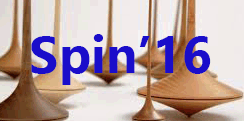Speaker
Description
Single transverse Spin Asymmetries (SSA) were first observed in hadro-production of inclusive charged pions at the ZGS at ANL in 1976. Over 40 years, these large asymmetries were found to persist in reactions at increasing center of mass energies in experiments at the AGS, FNAL and RHIC. Measurements of SSA in SIDIS at HERMES, COMPASS and Jefferson Laboratory were employed to separate competing mechanisms that can contribute to the inclusive SSA observed in hadron reactions: correlations between hadron spin and intrinsic transverse quark momentum in the initial state proposed by Denis Sivers, correlations between quark spin and intrinsic transverse quark momentum in the initial state first discussed by Daniel Boer and Piet Mulders and correlations between the transverse spin of the struck quark and the transverse momentum of hadrons in the final state suggested first by John Collins.
Significant theoretical progress has been achieved in understanding the origin of SSA in hard scattering processes based on a systematic treatment of transverse momentum dependent (TMD) degrees of freedom in QCD. The COMPASS experiment at CERN is presently verifying the surprising theoretical finding of TMD-QCD, that naïve T-odd distributions - i.e. the Sivers- and Boer-Mulders quark distributions, are process dependent and change sign between SIDIS and Drell-Yan processes.
In this paper, we will present the unique opportunity that will arise from measurements of di-muon Drell-Yan production with RF-separated anti-proton-, kaon- and pion-beams at the SPS M2 beamline for studying the TMD structure of protons and mesons. Measurements with the anti-proton beam will be used to achieve a model independent extraction of the proton Boer-Mulders quark distributions. With this input, the meson beams enable measurements of Boer-Mulders quark distributions for Kaons and Pions, for the first time. These data will make it possible to study the mass dependence of TMD effects in hadrons and to compare Boer-Mulders distributions for 2-quark and 3-quark bound states.
We will conclude with a discussion of cross section measurements that can be performed simultaneously and will yield greatly improved information on the quark-structure of Kaons and Pions. RF-separated hadron beams will provide unique insight in meson structure.
